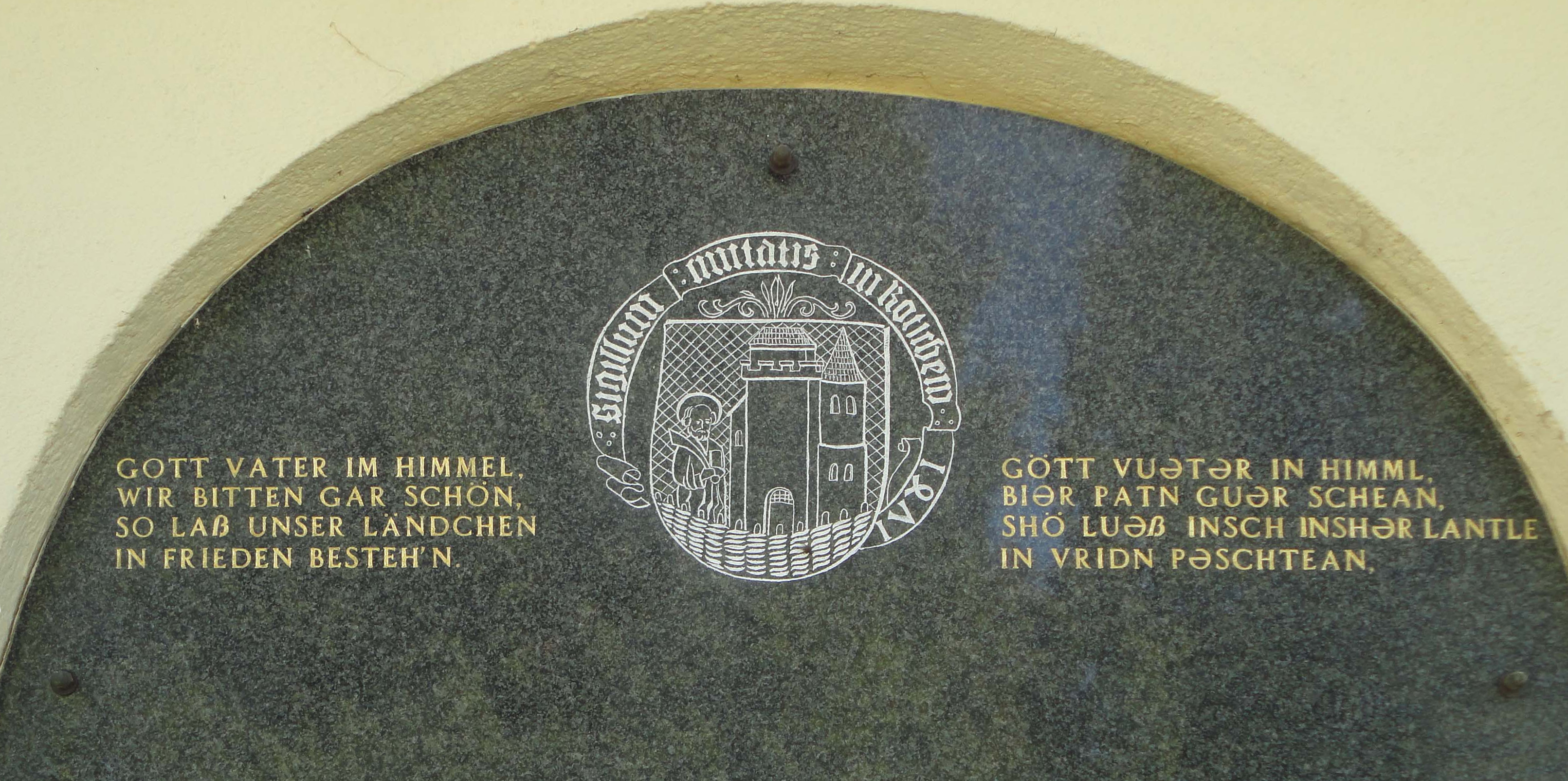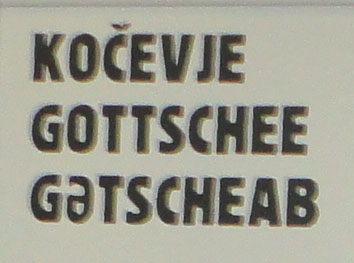Gottscheerish on:
[Wikipedia]
[Google]
[Amazon]




 Gottscheerish (''Göttscheabarisch'',Maridi Tscherne: Wörterbuch Gottscheerisch-Slowenisch. Einrichtung für die Erhaltung des Kulturerbes Nesseltal, Koprivnik/Nesseltal 2010. german: Gottscheerisch, sl, kočevarščina) is an
Gottscheerish (''Göttscheabarisch'',Maridi Tscherne: Wörterbuch Gottscheerisch-Slowenisch. Einrichtung für die Erhaltung des Kulturerbes Nesseltal, Koprivnik/Nesseltal 2010. german: Gottscheerisch, sl, kočevarščina) is an
/ref> In Slovenia there are some families who preserved Gottscheerish in spite of the ban after World War II. Today, however, there are probably no more children learning it as first language. Most Gottscheerish speakers live in Moschnitze valley (Črmošnjiško-Poljanska dolina) between Kočevske Poljane and Črmošnjice, where some Gottscheer families collaborated with the partisan movement and therefore were allowed to stay.Pokrajinski muzej Kočevje: Vsi niso odšli / Not all of them left
Gottscheer Relief Association, New York: Language Lessons. Gottscheerisch for English SpeakersKultura po 700 letih na robu propada
(Domen Caharijas, '' Dnevnik'', 17 October 2009, in Slovene)
parts of the body in Gottscheerish
{{Languages of Slovenia Languages of Slovenia Bavarian language German dialects




 Gottscheerish (''Göttscheabarisch'',Maridi Tscherne: Wörterbuch Gottscheerisch-Slowenisch. Einrichtung für die Erhaltung des Kulturerbes Nesseltal, Koprivnik/Nesseltal 2010. german: Gottscheerisch, sl, kočevarščina) is an
Gottscheerish (''Göttscheabarisch'',Maridi Tscherne: Wörterbuch Gottscheerisch-Slowenisch. Einrichtung für die Erhaltung des Kulturerbes Nesseltal, Koprivnik/Nesseltal 2010. german: Gottscheerisch, sl, kočevarščina) is an Upper German
Upper German (german: Oberdeutsch ) is a family of High German dialects spoken primarily in the southern German-speaking area ().
History
In the Old High German time, only Alemannic and Bairisch are grouped as Upper German. In the Middle High ...
dialect
The term dialect (from Latin , , from the Ancient Greek word , 'discourse', from , 'through' and , 'I speak') can refer to either of two distinctly different types of linguistic phenomena:
One usage refers to a variety of a language that is ...
which was the main language of communication among the Gottscheers Gottscheers are the German settlers of the Kočevje region (a.k.a. Gottschee) of Slovenia, formerly Gottschee County. Until the Second World War, their main language of communication was Gottscheerish, a Bavarian dialect of German.
Origins
T ...
in the enclave of Gottschee
Gottschee (, sl, Kočevsko) refers to a former German-speaking region in Carniola, a crownland of the Habsburg Empire, part of the historical and traditional region of Lower Carniola, now in Slovenia. The region has been a county, duchy, distric ...
, Slovenia
Slovenia ( ; sl, Slovenija ), officially the Republic of Slovenia (Slovene: , abbr.: ''RS''), is a country in Central Europe. It is bordered by Italy to the west, Austria to the north, Hungary to the northeast, Croatia to the southeast, and ...
, before 1941. It is occasionally referred to as Granish or Granisch in the United States (< German ''Krainisch'' 'Carniola
Carniola ( sl, Kranjska; , german: Krain; it, Carniola; hu, Krajna) is a historical region that comprised parts of present-day Slovenia. Although as a whole it does not exist anymore, Slovenes living within the former borders of the region s ...
n'), a term also used for Slovene. Today there are only a few speakers left in Slovenia and around the world.
Language history
Gottscheerish belongs to Southern Bavarian within the Bavarian dialect group. The Bavarian dialects ofCarinthia
Carinthia (german: Kärnten ; sl, Koroška ) is the southernmost Austrian state, in the Eastern Alps, and is noted for its mountains and lakes. The main language is German. Its regional dialects belong to the Southern Bavarian group. Carin ...
are closest to it. Gottscheerish shares a lot of properties with the Bavarian dialects of the German language islands of the eastern Alps, among them Cimbrian
Cimbrian ( cim, zimbar, links=no, ; german: Zimbrisch; it, cimbro) refers to any of several local Upper German varieties spoken in northeastern Italy. The speakers of the language are known as ''Zimbern'' in German.
Cimbrian is a Germanic ...
in Veneto
Veneto (, ; vec, Vèneto ) or Venetia is one of the 20 regions of Italy. Its population is about five million, ranking fourth in Italy. The region's capital is Venice while the biggest city is Verona.
Veneto was part of the Roman Empire unt ...
, Sappada (Pladen), and Timau (Tischelwang) in Friuli-Venezia Giulia
(man), it, Friulana (woman), it, Giuliano (man), it, Giuliana (woman)
, population_note =
, population_blank1_title =
, population_blank1 =
, demographics_type1 =
, demographics1_footnotes =
, demographics1_t ...
, and Sorica (Zarz) in Upper Carniola (Slovenia).
Gottscheerish developed independently for more than 600 years from the settlement of the first German-speaking settlers from Eastern Tyrol and Western Carinthia around 1330.
The Gottscheer Germans used Gottscheerish as oral language for daily communication, whereas their written language was Standard German
Standard High German (SHG), less precisely Standard German or High German (not to be confused with High German dialects, more precisely Upper German dialects) (german: Standardhochdeutsch, , or, in Switzerland, ), is the standardized variety ...
. However, folk songs and folk tales collected in the 19th and 20th century have been published in Gottscheerish.
Already in the 19th century many speakers of Gottscheerish left their homes to emigrate to the United States
The United States of America (U.S.A. or USA), commonly known as the United States (U.S. or US) or America, is a country Continental United States, primarily located in North America. It consists of 50 U.S. state, states, a Washington, D.C., ...
. After resettlement of most Gottscheers by the German occupation forces in 1941 during the Second World War
World War II or the Second World War, often abbreviated as WWII or WW2, was a world war that lasted from 1939 to 1945. It involved the vast majority of the world's countries—including all of the great powers—forming two opposi ...
only a few hundred speakers of Gottscheerish remained in their homeland. After the war Gottscheerish was forbidden in Yugoslavia
Yugoslavia (; sh-Latn-Cyrl, separator=" / ", Jugoslavija, Југославија ; sl, Jugoslavija ; mk, Југославија ;; rup, Iugoslavia; hu, Jugoszlávia; rue, label= Pannonian Rusyn, Югославия, translit=Juhoslavij ...
.
Present situation
According to theUNESCO
The United Nations Educational, Scientific and Cultural Organization is a List of specialized agencies of the United Nations, specialized agency of the United Nations (UN) aimed at promoting world peace and security through international coope ...
, Gottscheerish is a "critically endangered language". The majority of its speakers live in the U.S., with a significant community in Queens
Queens is a borough of New York City, coextensive with Queens County, in the U.S. state of New York. Located on Long Island, it is the largest New York City borough by area. It is bordered by the borough of Brooklyn at the western tip of Long ...
, New York City
New York, often called New York City or NYC, is the List of United States cities by population, most populous city in the United States. With a 2020 population of 8,804,190 distributed over , New York City is also the L ...
. Most of them are of the oldest generation, who spent their childhood in Gottschee County. There are speakers in Canada
Canada is a country in North America. Its ten provinces and three territories extend from the Atlantic Ocean to the Pacific Ocean and northward into the Arctic Ocean, covering over , making it the world's second-largest country by to ...
, Austria and Germany as well, but just as in the U.S. they have hardly any opportunity to practice it. Everyday language in the family and elsewhere is English and German or the local dialect, respectively.Anja Moric: Usoda Kočevskih Nemcev - Ohranjanje identitete kočevskih Nemcev. Diplomsko delo, Univerza v Ljubljani, 2007/ref> In Slovenia there are some families who preserved Gottscheerish in spite of the ban after World War II. Today, however, there are probably no more children learning it as first language. Most Gottscheerish speakers live in Moschnitze valley (Črmošnjiško-Poljanska dolina) between Kočevske Poljane and Črmošnjice, where some Gottscheer families collaborated with the partisan movement and therefore were allowed to stay.Pokrajinski muzej Kočevje: Vsi niso odšli / Not all of them left
Written representation
As a primarily or exclusively spoken language, the written representation of Gottscheerish has varied considerably. The following table shows how some of the more problematic phonemes have been represented in different writing systems. The symbol '' ə'' forschwa
In linguistics, specifically phonetics and phonology, schwa (, rarely or ; sometimes spelled shwa) is a vowel sound denoted by the IPA symbol , placed in the central position of the vowel chart. In English and some other languages, it rep ...
is frequently distorted in representations of Gottscheerish, incorrectly replaced by the partial differential symbol ∂ or umlauted '' ä''.
Phonology
The phonological inventory of Gottscheerish differs from standard German in a number of ways, especially regarding palatal consonants. The phonological inventory here is based on Hans Tschinkel's 1908 grammar. Tschinkel does not explicitly distinguish between phonemic and phonetic status.Consonants
Consonants in parentheses are either phonetic/positional variants,idiolect
Idiolect is an individual's unique use of language, including speech. This unique usage encompasses vocabulary, grammar, and pronunciation. This differs from a dialect, a common set of linguistic characteristics shared among a group of people ...
variants, or dialect variants.
In the westernmost part of Gottschee, known as the Suchen Plateau (german: Suchener Hochtal), the phonemes /s/ and /ʃ/ merged to yield /ɕ/ and the phonemes /z/ and /ʒ/ merged to yield /ʑ/. The phoneme /r/ is rarely realized as � The phoneme /l/ is realized as �after front vowels and after labial/velar obstruents.
Vowels
Tschinkel gives a large vowel inventory for Gottscheerish, especially for vowel clusters. He does not strictly distinguish between phonemic and phonetic values. Falling diphthongs: ''ai, ao, au, aʉ, ea, ei, ia, iə, oa, oɛ, oi, ou, ɵi, ɵʉ, ua, ui, uə, ʉi, ʉə, əi, aːi, aːo''Rising
Rising may refer to:
* Rising, a stage in baking - see Proofing (baking technique)
*Elevation
* Short for Uprising, a rebellion
Film and TV
* "Rising" (''Stargate Atlantis''), the series premiere of the science fiction television program ''Starg ...
diphthongs: '', , , , , , , , , , ː, , , , , ''
Falling triphthongs: ''oai, uai, eau, iəu, ʉəu, oːai, uːai''
Rising-falling triphthongs: '', , , , , , , , , , ''
Tetraphthongs: ''oai, , , ''
Grammar
Personal pronouns
The following pronouns are given in Hans Tschinkel's transcription.Numbers
The following numbers are given in abridged form in Hans Tschinkel's transcription.Tschinkel, Hans. 1908. ''Grammatik der Gottscheer Mundart.'' Halle: Max Niemeyer, pp. 265–266.Examples
A text in Karl Schröer's orthography (1870): A text partially based on Hans Tschinkel's orthography (ca. 1908):Notes
References
Bibliography
*Karl Julius Schröer: ''Wörterbuch der Mundart von Gottschee''. K. k. Hof- und Staatsdruckerei, Wien 1870. *Adolf Hauffen: ''Die deutsche Sprachinsel Gottschee. Geschichte und Mundart, Lebensverhältnisse, Sitten und Gebräuche, Sagen, Märchen und Lieder''. K. k. Universitäts-Buchdruckerei und Verlags-Buchhandlung ‚Styria‘, Graz 1895. S. 19-33: Die Gottscheer Mundart. *Hans Tschinkel: ''Grammatik der Gottscheer Mundart.'' Niemeyer, Halle a. S. 1908. *Walter Tschinkel: ''Wörterbuch der Gottscheer Mundart.'' 2 Bände. Mit Illustrationen von Anni Tschinkel. Studien zur Österreichisch-Bairischen Dialektkunde. Verlag der Österreichischen Akademie der Wissenschaften, Wien 1973. *Maridi Tscherne: ''Du höscht lai oin Hoimöt. Domovina je ena sama. Pesmarica pesmi v kočevarskem narečju.'' Slovensko kočevarsko društvo Peter Kosler, Ljubljana 2010. *Maridi Tscherne: ''Beartərpiəchla - Göttscheabarisch-Kroinarisch. Kočevarsko-slovenski slovarček''. Zavod za ohranitev kulturne dediščine Nesseltal Koprivnik, Koprivnik/Nesseltal 2010.External links
Gottscheer Relief Association, New York: Language Lessons. Gottscheerisch for English Speakers
(Domen Caharijas, '' Dnevnik'', 17 October 2009, in Slovene)
parts of the body in Gottscheerish
{{Languages of Slovenia Languages of Slovenia Bavarian language German dialects